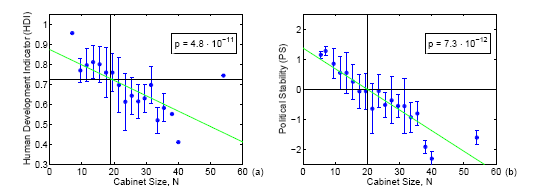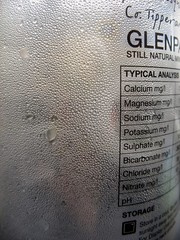August 22, 2008
Quantifying Inefficiency
Parkinson's law (or more properly, laws) are often regarded as humorous (true) statements about bureaucracy. The paper arXiv:0808.1684 Parkinson's Law Quantified: Three Investigations on Bureaucratic Inefficiency by Peter Klimek, Rudolf Hanel and Stefan Thurner demonstrates that they can be simulated fairly well.

They make an intriguing diagram of cabinet size vs. human development index and political stability for different countries. Clearly countries with 20+ cabinet members tend to be worse off than those with small cabinets.
The reason for the 20 people cut-off is revealed in another simple model. Cabinets are modelled as small-world networks where members take on the opinion of the majority of their neighbours. For small cabinets everybody convinces everybody. For larger cabinets the likelihood of getting stuck in a divided state increases linearly with size, with some form of breakpoint at 20. There is also a high tendency for size 8 cabinets to get stuck.
Further models of careers give numeric estimates of when bureaucracies tend to grow (essentially for all reasonable probabilities of promotion and number of subordinates) and how the age of retirement affects organisational efficiency. It turns out that there is an optimum retirement age that keeps experienced officials yet avoids having too many jealous and inefficient non-promoted officials. This grows with the number of levels of non-promoted subordinates.
All in all, it is a nice way of quantifying a few of the common-sense observations. I doubt adjusting retirement ages to organisation structures work well since other parameters (e.g. levels of resentment) may change faster, but the opinion formation model of cabinets seem to be something anybody involved in meetings and organisations should keep in mind. Most likely a way of increasing the number of contacts between cabinet members (increasing k in their notation) is a good way of improving opinion convergence.
BTW, Sweden has 22 members of cabinet. Oh dear.
August 20, 2008
My Collection of Collections
 I decided to put photos of my seashells and minerals online. Since they reside in Stockholm and I reside in Oxford this makes it possible to refer to them.
I decided to put photos of my seashells and minerals online. Since they reside in Stockholm and I reside in Oxford this makes it possible to refer to them.
The day I get ridiculously rich I will start building a big library with cabinets of natural curiosities. And hire somebody to dust them for me.
The psychology of collection is curious. It is more interesting to acquire than to own the stuff, whether it is chemical formulas for acids, mathematical paradoxes, minerals, seashells or scientific papers (all past or present obsessions of mine). Maybe it is just a hoarding reflex, but I think it has more to do with the dopamine kicks we get when we acquire. There seems to be plenty of books and studies already written on the subject, but I feel no desire to get them right now. I do not need to know why I tend to collect things, I just enjoy doing it - and thank everybody who has collected and organised before me, since they have helped science so much. Without the Rothschild Collection of Fleas, where would we be?
I don't like the digital drugs but the drugs like me
 Practical Ethics: Silicon dreams: digital drugs and regulation - I blog about the summer scare about "digital drugs". After all, if binaural beats can do all the wonderful things the believers can say, why can't they alter consciousness in recreational ways? And, as USA Today actually points out, even placebo effect drugs can have untoward effects. Of course, regulating placebo effects will not be possible so people will be interested in controlling the means of achieving them. A rather unworkable proposition.
Practical Ethics: Silicon dreams: digital drugs and regulation - I blog about the summer scare about "digital drugs". After all, if binaural beats can do all the wonderful things the believers can say, why can't they alter consciousness in recreational ways? And, as USA Today actually points out, even placebo effect drugs can have untoward effects. Of course, regulating placebo effects will not be possible so people will be interested in controlling the means of achieving them. A rather unworkable proposition.
I remember writing a program sometime around 1982 to flash the screen of my Sinclair ZX81 computer at the theta-rhythm frequency in order to make me smarter. Seems to have worked perfectly :-) The pattern I used looked much like the ugly Heathrow carpet above: maybe staring at it enough will induce some drug-like effect? Hmm, here is an idea for an aspiring woo-monger: make carpets generating the right brainwave entrainment as people walk across them. Remember, you heard of the idea here first!
August 08, 2008
The battle over the spirit of sport
 Just in time for the OS opening: Synen på dopning behöver förnyas (Göteborgs-Posten, Waldemar Ingdahl and Julian Savulescu) and Lika bra att nu tillåta dopning i elitidrotten (Dagens Nyheter, Torbjörn Tännsjö and Claudio Tamburrini). Two simultaneous doping harm reduction articles in major Swedish newspapers by philosophers I know and like (full disclosure, Waldemar and me are in the same think tank, and Julian is down the hallway from my office).
Just in time for the OS opening: Synen på dopning behöver förnyas (Göteborgs-Posten, Waldemar Ingdahl and Julian Savulescu) and Lika bra att nu tillåta dopning i elitidrotten (Dagens Nyheter, Torbjörn Tännsjö and Claudio Tamburrini). Two simultaneous doping harm reduction articles in major Swedish newspapers by philosophers I know and like (full disclosure, Waldemar and me are in the same think tank, and Julian is down the hallway from my office).
Waldemar Ingdahl and Julian Savulescu builds on arguments I wrote about in Captus Tidning (in Swedish) and Julian (among other places) on Ethics in the News. The key issue is that "the spirit of sport" is only relevant for people interested in sports culture: if I, a sedentary academic, want to take an enhancer (like the very promising exercise mimetics recently announced by Narkar et al.) I am now prevented from doing so by rules intended to safeguard the sports business (sport is part of the entertainment business; see The Economist's special report on it). As more and more medical treatments are developed to prevent illness, enhance normal function and improve recovery the strain between doping and non-athletic medicine will become unbearable. The pragmatic approach is to deal with the real problem: reduce harm, whether from doping or excessive training - prevent people with unhealthy hematocrit levels from participating in sport rather than try to find the ones who have taken EPO.
Tännsjö and Tamburrini argue that doping testing is hypocritical and deliberately ineffective - the "war on doping" is going as well as the "war on drugs" and "war on terrorism". They also suggest maximum hematocrits and similar health controls, as well as the interesting (and no doubt practically messy) possibility to even out unfairness in sport by deliberate enhacement. Better to enhance openly, under medical supervision than leave it to the shadows.
The big problem with doping is not within sports, but how it deforms rules and values outside sport. Athletes accept extreme surveillance regimes that are far beyond those required for nuclear power plant workers - and would be stuck down as against their integrity if ever proposed. Yet laws are created that enshrine the right of a certain business to control its contract workers' bodies and souls. Athletes are treated as potential criminals - and they are supposed to be exemplars to us! Taking enhancers is often denounced as "doping", yet the agreed on rules or "spirit" of education, health or living an enjoyable life are utterly different. The doping hunt is casting a shadow over many legitimate activities and diverting resources from where they could be better used.
I think the hope may come from something Andy Miah pointed out: the cyborg athletes. Pistorius and the others are heroes that more and more people admire. Yet they are direct challenges to the "spirit of sport" in a narrow sense by having artificial body parts. The spirit of sport we admire is overcoming any obstracle with style, strength of will, ingenuity and a spirit of play - but this is something technology independent. Artificial legs, PPAR-delta agonists, hi-tech swim suits or front crawl swimming are just ways of expressing it.
August 05, 2008
Smoke in the Water
 Nicotine Water is giving me a headache. Not directly, since I have never tried it, but because of the sheer amount of rule-bending going on around it.
Nicotine Water is giving me a headache. Not directly, since I have never tried it, but because of the sheer amount of rule-bending going on around it.
My general standpoint is that adult people should be allowed to consume whatever drugs they like if they have informed consent. Putting nicotine in water removes the secondhand smoke issue, definitely avoids the lung cancer and probably most of the other cancer risks, and even removes the unattractive aesthetics of snuff and snus. The volume makes abuse difficult. So I think the FDA were wrong when they banned it in 2002, just like a lot of other bans on smokeless nicotine products are excessive. Harm reduction tends to work better than zealous insistence on abstinence.
But the producers have found a way around the ban, or rather two ways. One silly, the other truly headache-inducing. Since the 4mg version now contains tobacco, it can be sold in the same manner as other tobacco products. It is no longer a drug, but just very dilute tobacco. The other one is a "homeopathic formulation" that contains less than half a milligram of nicotine, but through the magic of homeopathy (i.e. placebo) it is claimed to be 75% as effective.
Homeopathy is bunk, as demonstrated every day in every chemistry lab since the most common way of making dilute solutions is to dilute them - if homeopathy had worked the results from practically any experiment in biochemistry would have shown increasing efficacy for increasing dilution, which they don't. However, it is bunk that is widely believed and has regulator approval, which means that it is OK to sell homeopathic nicotine.
What I expect is that the FDA will claim the water is not dilute enough to be really homeopathic - it actually contains an active substance! (GlaxoSmithKline, a major manufacturer of anti-smoking aids, sent this letter to the FDA to warn them about the homeopathic gambit) At the same time I expect the homeopathic community also to attack it because it is not done in the right way (i.e. theirs), and besides they want to sell their anti-smoking products too. By the logic of homeopathy, a real homeopathic dilution of nicotine (which is in their pharmacopoeia already) would remove the effects of nicotine from the body - so they ought to think this is a great anti-smoking treatment. So they ought to argue that selling the water at a low dilution is false marketing, since it needs to be more dilute to get full effect.
What probably will get the company is the apparently scientific claim that it only releases 1/6th the amount of dopamine that would be normal for the dose. Maybe they have actually done the experiment, but it certainly sounds like out-of-context data.
The advertisements for NICLite water (a competitor) claims: "The procedure essentially scrubs and polishes the nicotine molecule leaving it more water miscible, palatable and less irritating to mucous membranes." AARGH! My head! Either the homepaths have invented picotech, or their marketing types are simply lying. "Our process produces an organic nicotine molecule..." OK, normal nicotine C10H14N2 apparently doesn't contain carbon. The stupidity burns - and the worst thing is that they think everybody else is more stupid than them.
Actually, I wonder if believers in homeopathy thinks it is possible to make recreational drugs using their method. According to Hahnemann's law of similarity we should take a substance that would produce symptoms of what we want to "cure". So let's take something that makes us drowsy, like valeriana. Then dilute it a large number of times with intermediary shaking, and - voila! - you get a powerful stimulant. Great news for any would-be drug pusher: it is cheap, undetectable and safe. But no doubt the believers will just shake their heads and claim their remedies can only restore balance. Which would imply that they are totally useless as enhancers, and that taking the entire homeopathic pharmacopoeia ought to make you extremely healthy. I wonder how many athletes in Beijing who are on homeopathic doping?
August 03, 2008
Another Threat from the LHC
 symmetry breaking » Rapping the LHC - another global catastrophic risk from the LHC, scientific rap!
symmetry breaking » Rapping the LHC - another global catastrophic risk from the LHC, scientific rap!
Actually, it is not that terrible compared to much that is out there. And the science is right and illustrated with infographics.
What really caught me was the previous rap, N3UROCH!P, dealing with this paper: Itay Baruchi and Eshel Ben-Jacob, Towards neuro-memory-chip: Imprinting multiple memories in cultured neural networks, Phys. Rev. E 75, 050901(R) (2007). Now that is a rap subject I can really get into!
Maybe there ought to be a rule that every scientific paper that is written should either have a popular science explanation posted on the web, or something more fun like a rap video?
August 02, 2008
iThink Different
The Monkey Buddha: Introducing the "iThink" is a small concept sketch for "the interface of the future". Nothing unusual, just a neural interface with a linked quantum processor, a few hundred yottabytes of information and of course a global iThink mental network.
What I think is the interesting part here is not the device - it is a sf staple - but the question raised: how would it be *designed* and marketed? Design is a great part of what determines success and usability.
For example, part of the success of the iPod was simply having iconic white headphones that signaled its presence and brand. The iThink is doing the same - there is absolutely no reason to have a visible external device on top of the neural interface. It could have been subdermal or hidden under clothing. But if you can see that somebody is on iThink that person will be a walking piece of marketing - and if the brand is good people will want to be seen with it. Feedback ensues until we are all iPodlings and iThink borganisms.
Pandemic Pandemic Game
 The game Pandemic 2 seems to be sweeping the Internet. Very fitting that a game about infectious disease is a viral success.
The game Pandemic 2 seems to be sweeping the Internet. Very fitting that a game about infectious disease is a viral success.
As a player one "controls" a disease, trying to wipe out all of humanity. As more people succumb to the disease it gets "evolution points" that can be used to buy new symptoms, resistances and properties. As the pandemic spreads governments try to stop it - issuing curfews, closing airports, killing pests or working on a vaccine. The real game is to manage to infect all areas of the planet before everything is closed down, and then to ensure that the hospitals working on a cure are closed.
As discussed on jayisgames.com the game itself has many flaws. Getting paranoid, isolated Madagascar is hard and a matter of pure luck. The interface has many problems and there is a lack of control that makes the game unexciting. It reminds me of the classic Balance of Power which was so realistic that it was unplayable. Yet there is a feel that inside this game there is a great game that is waiting to be born.
As one commenter remarked, the game would not work if it was not about wiping out the real world - the same dynamics in a fantasy setting simply doesn't work. The real reason the game is catching is that it is about the real world. A somewhat unrealistic model maybe, but close enough to SARS, avian flu and the 1918 flu to make sense. It is hard not to imagine the scenes as nations close their borders and desperately try to research a vaccine while society is crumbling under the onslaught of feverish, hemorrhaging victims. Or the Malagasy riding out the apocalypse on their island. The sheer abstraction of the game adds an imaginative dimension to it.
I wonder about the motivations for making this game. Sure, wiping out humanity is enjoyable as a game (witness the various nuclear war games) - we all have a little apocalypse enthusiast somewhere in our brains telling us that it would be neat if the world ended in some dramatic way. But the game also seems to teach a fairly good lesson about what makes a truly nasty pandemic: a long incubation time, the ability to stay under the radar of containment attempts and a decent infectiousness. I doubt this is intended as hands-on training for would-be bioterrorists. Rather I think it helps people see a threat that often remains remote. I wouldn't be totally surprised if the CDC or DHS had supported the development of the game, for educational and maybe political purposes. Because it no doubt contributes to the availability heuristic: after playing this game I would expect people to rate the risk of pandemic megadeath significantly higher. Which would be a good thing if it could be converted into rational policy - on average people seem to treat pandemics too lightly. Maybe some light gaming can help.
August 01, 2008
Eugene the polymath and the antihumanism of transhumanism
 Two Bits: The Cultural Significance of Free Software » Chapter 2: Protestant Reformers, Polymaths, Transhumanists, an online book by Christopher M. Kelty, has an interesting description of transhumanism. In particular it spotlights my friend Eugene as a fine specimen of the species.
Two Bits: The Cultural Significance of Free Software » Chapter 2: Protestant Reformers, Polymaths, Transhumanists, an online book by Christopher M. Kelty, has an interesting description of transhumanism. In particular it spotlights my friend Eugene as a fine specimen of the species.
Kelty concludes that:
Transhumanism is a radically antihumanist position in which human agency or will—if it even exists—is not ontologically distinct from the agency of machines and animals and life itself. Even if it is necessary to organize, do things, make choices, participate, build, hack, innovate, this does not amount to a belief in the ability of humans to control their destiny, individually or collectively. In the end, the transhumanist cannot quite pinpoint exactly what part of this story is inevitable—except perhaps the story itself.
I do not think all transhumanists agree, but it is a good point that needs to be expressed. It is quite close to the Nietzschean vision of the Will to Power, expressing itself through a lot of activity among a lot of organisms producing the grand and frightening flowering of the world.
Technology does not develop without millions of distributed humans contributing to it; humans cannot evolve without the explicit human adoption of life-altering and identity-altering technologies; evolution cannot become inevitable without the manipulation of environments and struggles for fitness. As in the dilemma of Calvinism (wherein one cannot know if one is saved by one’s good works), the transhumanist must still create technology according to the particular and parochial demands of the day, but this by no means determines the eventual outcome of technological progress. It is a sentiment well articulated by Adam Ferguson and highlighted repeatedly by Friederich Hayek with respect to human society: “the result of human action, but not the execution of any human design.”
I'm reminded of the strangeness of Hayek's spotaneous orders: they are actually all designed by human ingenuity to meet demands humans see, but when they interact with the market, each other and the environment they gain a dynamics of their own. Success or being subjected to creative destruction rarely occurs because somebody planned it that way. Rather, it happens because of tremendously complex interactions that produce emergent effects.
The technocratic vision of planning the best future is anathema to modern transhumanism: even if it was possible, it would cut away all choice and possibility, by necessity becoming coercive. This is why modern transhumanists are so dynamistic (and critical of the collectivist utopias painted by Stapledon). But being dynamist about the future also requires faith that it is bright and worthwhile: we want to actually get there.
Of course, being antihumanist in the sense that humans are not fundamentally different from the rest of the local biosphere and technosphere does not mean one has to be antihumanist in the sense of disregarding the importance of universal qualities such as rationality, the ability to find meaning and attempting to shape one's life. Rather, we should be on the lookout for such qualities in the systems around us, and find ways of nurturing them. It is just that we cannot be certain at all that these are unchanging, fundamental things that must win in the end (but we will do what we can to get there!) or that we will not discover new qualities we might also want to pursue. After all, given how great it is having language, consciousness and art, we should suspect that there might be equally fantastic things out there in the space of possible minds.